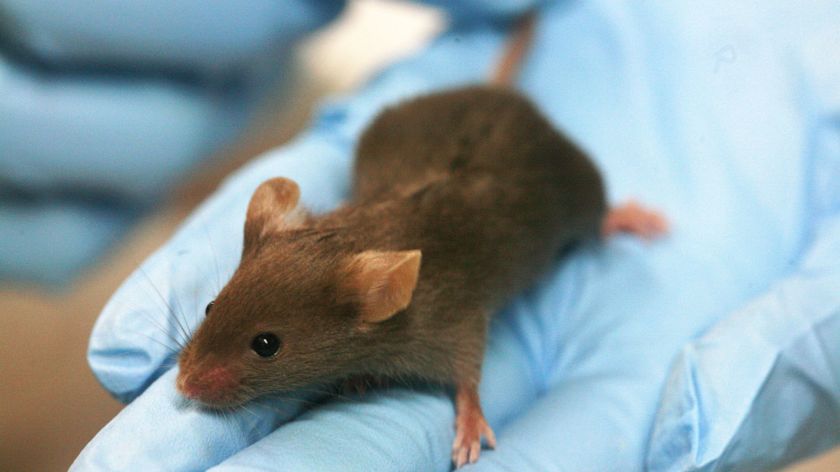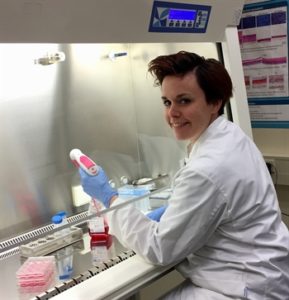Fewer test animals thanks to artificial skin
-
 Foto: Global Panorama (creative commons)
Foto: Global Panorama (creative commons)
Artificial skin that is indistinguishable from real skin. This is the tissue dermatologist Ellen van den Bogaard uses in her research on the influence of bacteria on diseases of the skin. What came first? The disease or the bacteria?
It is the result of fifteen years of honing and refining: artificial skin. And it is completely indistinguishable from the real stuff. In fact this artificial skin is made of real skin cells. To create it, researchers used left-over cells from abdominoplasties. On a small membrane the size of a little finger nail cells are grown until they form an epidermis, an outer skin layer. Et voilà: there is your artificial skin. Just as in real life, the top layer of the artificial skin is exposed to open air. The underside is suspended in a liquid filled with nutrients that the cells use to grow. Researchers can also add other substances to this liquid, for example to imitate diseases.
Chicken or egg
Radboudumc dermatologist Ellen van den Bogaard uses artificial skin to investigate diseases of the skin such as psoriasis and eczema. Specific bacteria may play an important role in these diseases, although it is as yet unclear how. Van den Bogaard was awarded a grant by scientific organisation NWO (their medical branch is called ZonMw) to culture bacteria in artificial skin. Artificial skin that contains bacteria – in jargon: a skin microbiome model – mimics human skin even more closely as human skin contains both good and bad bacteria. When skin becomes diseased, as in psoriasis and eczema, it develops more or fewer of certain types of bacteria than healthy skin. The artificial skin Van den Bogaard is planning to develop will help her to find out whether the bacteria make the skin ill. Or is it the other way around, and do the bacteria appear because the skin is diseased? Van den Bogaard: ‘It’s the old chicken and egg story. What comes first? The disease or the bacteria?’
‘There is a lot of pressure from society to find an alternative to animal testing’
Van den Bogaard plans to use artificial skin to investigate how bacteria and skin cells influence each other. Ultimately she hopes to develop antibiotics that specifically target the pathogenic bacteria, rather than killing everything they encounter. The question is whether specific nutrients can also help promote healing. Van den Bogaard: ‘Think of those little Yakult bottles full of probiotics – the good bacteria.’ She hopes to find out whether skin recovers when treated with a cream containing probiotics.
Animal testing
In the Netherlands researchers perform more than 600,000 experiments per year involving test animals. Van den Bogaard: ‘There is a lot of pressure from society to find an alternative to animal testing.’ With the artificial skin she hopes to dramatically reduce the number of animal tests. Researchers who now first test new drugs for specific skin diseases on test animals will soon be able to use artificial skin instead. Although this will not entirely eliminate the need for test animals. Van den Bogaard: ‘Especially in later stages of drug development, we cannot yet do without test animals. Personally I wouldn’t want to take a drug that had only been tested in a culture dish. To find out whether a drug is really safe, we still have to test it on animals at some point.’

Burns
In the future doctors hope to be able to use artificial skin to treat burns. ‘Science has been busy growing skin for burn patients for more than thirty years’, says Van den Bogaard. However this is very difficult. The skin produced in this way does not adhere well and the body rejects the cultured skin. Doctors therefore still treat burn patients with skin from their own body. This makes it less likely that the skin will be rejected. Van den Bogaard hopes that doctors will soon be able to treat burns with artificial skin. ‘Medical technology is developing so fast that I expect this to be possible within ten years,’ says the research physician.
The Netherlands Foundation for Burn Injuries and Wounds (Brandwondenstichting) is involved in her research. The Foundation hopes to use artificial skin soon to develop new antibiotics to combat burns. Van den Bogaard: ‘Our artificial skin can play an important role in this process, because infections often pose a serious problem for burn patients.’
Some researchers are currently experimenting with artificial skin on a chip. If you add liver or kidney cells to the skin, you can investigate the effect of a drug on multiple organs at once. What you are actually doing is mimicking the human body on a chip. Almost an entire organism on a sliver of glass. But we still have a long way to go, says Van den Bogaard. She expects her experiments with adding bacteria to artificial skin to attract attention from fellow dermatologists. ‘It would of course be wonderful if labs across the world could use our skin model. I believe it really makes better science possible, with a lot fewer test animals.’



